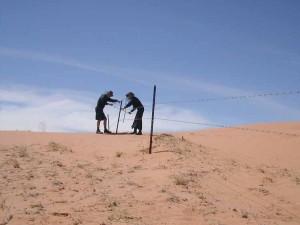‘The Great Australian Silence’ was a cultural codification for the domination of Australia’s lands by British Imperialists in 1788. The term was coined in 1901, when the Bulletin editor A.G. Stephens used the expression to ‘codify an Australian myth’ that the Australian identity was born ‘in the silence of the bush’.

1. Jon Rose and Hollis Taylor bowing a fence in the Strzelecki Desert, south-west Queensland, 2004. Image courtesy Hollis Taylor and Jon Rose. Photograph by Jon Rose.
This edict imposed the force of white law upon the acoustic soundscape of Australia’s ancient territories.[1] Of course, the bush was never silent, nor uninhabited. It was a native landscape filled with the songs and languages of over 400 indigenous clans.
Indigenous Australians passed on their traditions and knowledge orally, in song, dance and stories. With the loss of indigenous languages, the psycho-acoustic nature of the landscape of the Australian bush was transformed. Indigenous scholar Jane Belfrage writes: ‘The invaders’ practice of knowledge devastated the Australian knowledge soundscape. Grievous silences were imposed as the indigenous peoples were killed and removed and forbidden by law to speak their languages: a silencing of the sounds of Australian knowledges. Utterers of English sounds colonised acoustic spaces as they “extended the frontiers”.’[2]
Australia’s nostalgic recordings, which now find new life in both public and virtual space, emblematise white Australian culture. In many ways, Australia’s early radio history represents the ‘colonised acoustic spaces’ which Jane Belfrage writes about. Radio broadcasting was in every way a ‘frontier’. Whilst white historians are now articulating media history for a modern Australian society, Indigenous archivists, historians and cultural leaders are also building community networks, repositioning their reclaimed histories at the forefront of Australian cultural discourse.
[For more, read the special Arts of Sound November 2009 Issue of Art Monthly Australia www.artmonthly.org.au]
Carla Teixeira
Carla Teixeira is an audiovisual archivist with Australia’s National Film and Sound Archive (NFSA). It is the role of the NFSA to collect, preserve, interpret and share the nation’s historic and contemporary screen and sound cultural heritage. Carla collects, preserves and curates sound culture, with a focus on building the NFSA’s contemporary holdings in radio, independent music, experimental music and sonic art.
Read More
Jon Rose & Hollis Taylor – Great Fences from ANAT on Vimeo.
This content is sourced from the DVD which compliments the November 2009 ‘Arts of Sound’ issue of Art Monthly Australia, guest edited by Douglas Kahn and co-presented by ANAT. This work is covered under a Creative Commons Attribution-Non Commercial Share Alike 2.5 BY-NC-SA licence creativecommons.org/licenses/by-nc-nd/2.5/au/. Note – Please be aware the work may contain flashing and or flickering lights.
References
[1] R. Bandt, M. Duffy, D. MacKinnon, Hearing Places, Sound, Place, Time and Culture, Cambridge Scholars Publishing, Newcastle upon Tyne, United Kingdom, 2007, p. 39.
[2] Bandt, Duffy and MacKinnon, 2007: p. 39; quoting Belfrage’s unpublished M.A. thesis The Great Australian Silence: Knowing, Colonising and Gendering Acoustic Space in Women’s Studies and Philosophy, submitted to La Trobe University, Melbourne, December 1993.
 This work is licensed under a Creative Commons Attribution-NonCommercial-ShareAlike 2.5 Australia.
This work is licensed under a Creative Commons Attribution-NonCommercial-ShareAlike 2.5 Australia.






